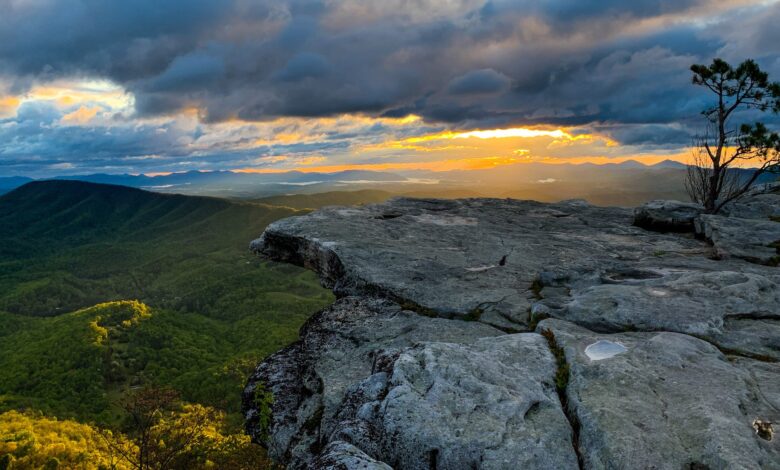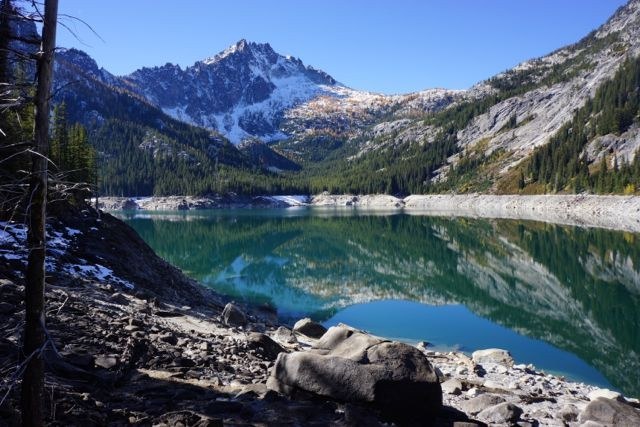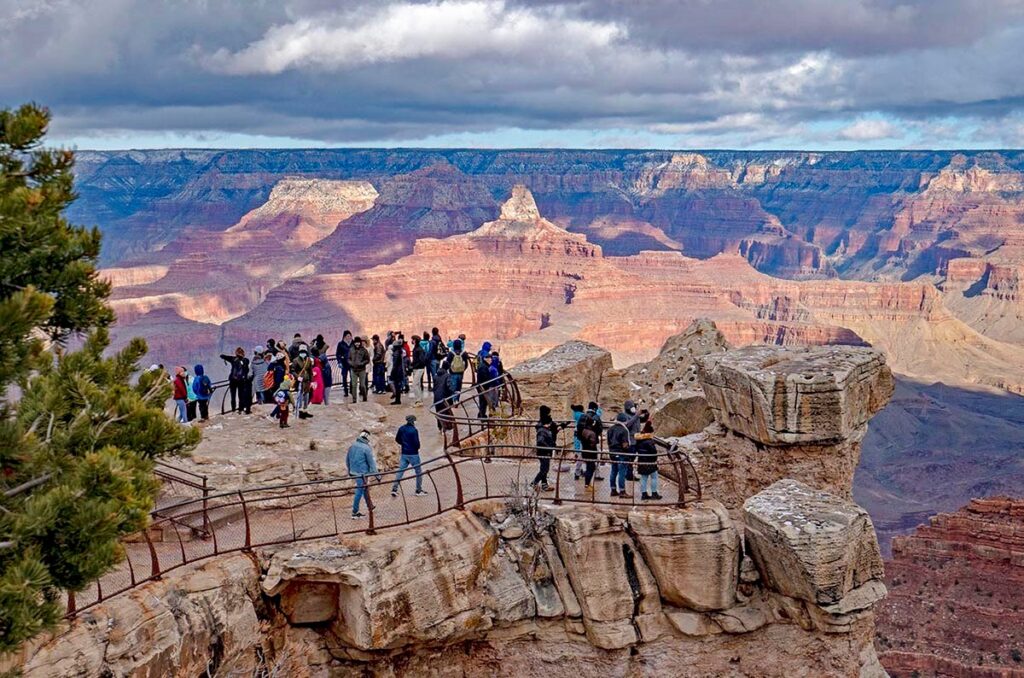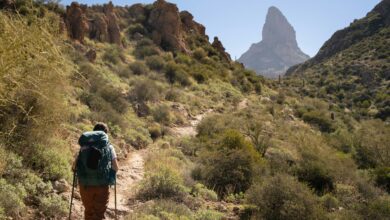The 11 Best Places to Backpack in the United States

It’s not easy to pick the right backpacking destination. Firstly, there are dozens of tempting options. Then, there is the question of matching your travel dates with the appropriate place. Moreover, the right trail selection needs to be based on the skill levels of your companions.
Honestly, balancing so many factors can seem intimidating. So, having a ready list of the best backpacking trails in the US helps. We have picked some of the top options based on our personal experiences over the years. These trails will earn top marks from any nature lover in terms of the scenery they present before you.
1. Glacier National Park, Montana
Difficulty: Easy to Moderate
Glacier National Park takes the top spot not because it’s one of my favorite backpacking destinations, but because it has epic trails that hikers with all levels of experience can enjoy. With more than 700 miles of trails to explore, this amazing Park is a haven for nature lovers with its numerous azure lakes, towering glacial cliffs, and alpine meadows.
With 71 mammal species and 276 bird species thriving in the Park, the wildlife views are extraordinary. I had one of the closest and scariest encounters with a grizzly while on a trail in the Park. At the same time, I got fascinating views like those of a herd of mountain goat expertly navigating rocky slopes near Bowman Pass.
Even if you spend multiple summers exploring the Park, there will be unseen delights awaiting you around the next corner. Some of the must-visit routes are the Many Glacier area, the Ptarmigan Tunnel, Cracker Lake, and the Highline Trail.
For more remote and forested trails, visit the western half of the park. On the eastern side, the trails are higher and the vistas more expansive. Make sure to get a wilderness permit for overnight camping trips in the park.

2. Snow Lake Trail, WA
Difficulty: Moderate
Just a stone’s throw away from Seattle, the Snow Lake Trail is one of my all-time favorite hiking routes because of the views. The total elevation gain is around 1,700 feet, and the best time to visit is from July to October. I have even done it in winter, when the trail is tougher, but the views are sublime. But I suggest attempting this trail in winter only if you are an experienced winter hiker and know what to wear while hiking in winter.
The Snow Lake trail doesn’t make you wait long for the views, and you clear the tree cover within a short period of hiking. The trail splits from the Source Lake junction, and the section from here to the top of the saddle is steep and rocky.
While the round trip is around 7 miles, the exact length depends on how far around the lake you decide to hike. For the best views, continue further along the shore for around another half a mile.
Worth mentioning that this is the most frequented trail in the Alpine Lakes Wilderness and gets crowded on weekends. So, manage your expectations accordingly.
3. Mount Whitney Trail, CA
Difficulty: Hard
The 10.7-mile ascent of this trail to the top of the imposing Mt. Whitney is the perfect option for those looking for something more adventurous. Rising at an altitude of 14,505 feet, Mt. Whitney is the highest point in California. That means you need to acclimate to reduce any risks of altitude sickness on the trail. Hikers usually spend a few nights in Lone Pine and visit the Horseshoe Meadow for that.
The trail is a 22-mile round trip, and the elevation gain is around 6,100 feet. The success rate of the hike is 27.3 percent, and that tells you how challenging this day hike is. However, the views of the Owens Valley and the Great Western Divide from the top are fantastic.
While the ascent is strenuous, the trail is non-technical, and anyone in decent shape can attempt the climb. For some extra support, carrying reliable trekking poles is a good idea.
Let me add that there is a more challenging mountaineer’s route to the top that beginner mountaineers looking for some experience can attempt. But first, you need to win a lottery conducted by the U.S. Forest Service for the permit.

4. Zion National Park, UT
Difficulty: Easy to hard
Trust me, watching fiery sunsets light up the iconic red sandstone cliffs in Zion National Park is a magical experience. But beyond the cliffs and arid deserts, the Park has lush valleys and dense forests as well.
Depending on your timeline, you can choose from day hikes to overnight backpacking trails. Overnight trails need more preparedness, but they allow you to explore the remote corners of the Park and the stunning views. The grade of each trail varies from easy to strenuous. Some of the trails start easy and get challenging as you progress.
One of my favorites is the La Verkin Creek Trail, which offers fantastic cliff views along its 14.4-mile length. The other option is to hike the Narrows, wading through the waters of the Virgin River to beat the summer heat. For a full day hike, choose the less-frequented trail to the Right Fork of North Creek that takes you to the gorgeous Barrier Falls.
5. Silver Lake, UT
Difficulty: Easy
Silver Lake is at the head of Big Cottonwood Canyon at 8,760 feet and is a beautiful hiking destination all through the year. The fact that half of the trail is a boardwalk due to the wetland environment may make it sound less attractive. But give it a chance, and the setting of Silver Lake will leave you surprised.
What makes the trail impressive is the rich biodiversity surrounding it. While I haven’t seen large animals on this trail, other hikers have reported seeing moose. Between mid-July and late August, the wildflower displays make the trail even more picturesque. If possible, plan a visit during midweek to avoid the crowds.
The 0.9-mile trail loops around the lake, and there are picnic tables and fishing access points along the pathway. To make things more interesting, you can move to other trials that join the loop. These include the Lake Solitude Trail, the Twin Lakes Trail, and the Brighton Lakes Trail.

6. Grand Canyon National Park, AZ
Difficulty: Moderate to hard
A grand testimony to the history of our planet, the Grand Canyon National Park is a fascinating canvas of shapes and colors. While there are multiple backpacking trails in the park, the most popular one is the Rim to Rim hike. While the hike is of a moderate level of difficulty, the logistics can be challenging.
Personally, I find the viewpoints along the South Rim to be the best. Experienced hikers can choose the out-and-back Bright Angel Trail, which is more challenging. This is a multi-day backpacking trip that is open all year round. The visual revelation of the grandness of the canyon as you stand on the rim is stunning.
The other point-to-point option is following the South Kaibab Trail and reaching the Grand Canyon Village. You can stop at Bright Angel Lodge, Phantom Ranch, and Havasupai Gardens. The 16.5-mile route is easy at the start but gets tough when you climb up from the canyon bed.
7. Sky Pond via Glacier Gorge Trail, CO
Difficulty: Moderate to hard
The Rocky Mountain National Park is another favorite backpacking destination for me, and the Sky Pond hike via the Glacier Gorge Trail is a great adventure. The out-and-back trail is 9.4 miles long, which doesn’t sound much. But the altitude of Sky Pond is 10,880 feet, which means you need to take it slow.
While the main trail isn’t difficult, the last section gets challenging. Besides, if there is snow on the higher portions of the trail, some scrambling may be needed. But in the end, the views are worth it. You get to see glimmering alpine lakes, large waterfalls, wildlife, along with great views of Taylor Peak, Powell Peak, and the Sharkstooth.
A few years back, I did this trek in winter to test out my new snowshoes. While it was challenging, the views were incredible. However, the best time is between mid-June and September. Thunderstorms are common in the area during summer, so stay prepared. Make sure to book your entry time to the National Park in advance.
8. Teton Crest Trail, WY
Difficulty: Moderate to hard
The Grand Teton National Park is a fantastic backpacking location, and the Teton Crest Trail combines stunning vistas with campsites overlooking gorgeous Alpine scenery. This camping trip can be done in 3-5 days, and the length can be between 35-45 miles, depending on your route.
If you want to do the full hike, start from Phillips Pass. Or else you can take the aerial tram at Jackson Hole and hike to the String Lake trailhead. The trail will take you through the Bridger-Teton and Caribou-Targhee National Forests, and the average altitude is around 8000 feet
The highlights of the trail inclue colorful carpets of wildflowers and grand views of the jagged Teton Range. The striking views of sunrises and sunsets from the campsites are a bonus.
You can extend the journey by adding challenging side trips like Hunt Mountain or Static Peak. Plus, there are options for off-trail explorations to the Icefloe Lake and Kit Lake. As such, the trail isn’t technically demanding, but remember, snow can linger on the passes till late summer.
9. Paria Canyon, AZ
Difficulty: Hard
If you’re looking for a less crowded option for canyon backpacking, the Paria Canyon in Vermilion Cliffs National Monument is the perfect destination. The terrain will look similar to the Narrows of Zion, as you will be wading down a river with narrow walls closing on you, but it feels more remote.
The entire trail length of the Paria Canyon is around 38 miles, and it is best covered in a 4-day/3-night camping trip. You can start from the Wire Pass Trailhead and end at Lee’s Ferry. If you have less time, start from Wire Pass and end at the White House campground on day 3.
Keep in mind, hiking through the river is a slow process. Also, be prepared for a heavy pack, as carrying all your food for the trip is necessary. You will need to apply for a permit, and overnight entry is limited to 20 people per day.
This ancient canyon has spots that will bring out an involuntary “wow” from your mouth. I was wowed when I saw the Slide Rock Arch for the first time. Besides, venturing into the winding corridors of stone in the Buckskin Gulch and exploring the 16 miles of unique formations is a special experience.

10. McAfee Knob via Appalachian Trail, VA
Difficulty: Easy
This 8-mile out-and-back hike takes you to the top of McAfee Knob at the northeast ridge of Catawba Mountain. This 3,197 feet high rock point is probably the poster image of the Appalachian Trail, and offers a fantastic 270-degree panorama.
The nearest major city to the trailhead parking is Roanoke, VA. Note that the parking lot fills up early, especially during weekends. The trail is at its colorful best during late spring and early summer when the wildflowers start blooming. Fall is another great time for this hike.
I’d suggest camping for a night in the area as the sunrise views from McAfee knob are spectacular. Note, that camping is prohibited near the Knob. You can hike past the Knob for almost a mile till you reach Pig Farm Campsite or Campbell Shelter. Next morning, enjoy the sunrise and then head back to the trailhead.
11. Alum Cave Trail to Mount LeConte, TN
Difficulty: Hard
This 10-mile round-trip is a beautiful trail in the Great Smoky Mountains National Park and is noted for its natural geological markers. The elevation gain as you move up the trail is around 2,700 feet, which makes it strenuous. However, there are no technically challenging sections. Make sure to fill your hydration bladder before you start, as water sources on this trail are limited.
The gradual ascent through heavily forested sections at the start serves as a warm-up for the steeper portions that you face later. After that, you reach Arch Rock, a staircase carved into the rock that has taken an arch-like shape. Next comes the Alum Cave Bluff, an impressive 80-foot-tall overhang that serves as a resting point.
Just below the peak is the LeConte Lodge, where you can take a break for a snack. Spending a night in the lodge will require a prior reservation and some luck. On a clear day, the views from the cliff top area are breathtaking. If you have time, hike further to reach Myrtle Point, which offers some of the best Great Smoky Mountains views.
Close Runners Up
If you don’t have the time to tackle a thru-hike, here are some options that are easier to pull off, but score high in terms of scenery. In case you’re looking for the best backpacking trails in the US that are longer and more intense, there are options too.
Ouzel Falls via Wild Basin Trail, CO
This 5.4-mile-long out-and-back hike follows the North Saint Vrain Creek at the southeastern edge of Rocky Mountain National Park. Along the trail, you will pass the beautiful Copeland Falls and Calypso Cascades – perfect spots for those who love photographing waterfalls. The trail gets more adventurous in spring as everything is covered by snow.
Acadia National Park, ME
There are some amazing hikes in Acadia National Park, and most of them are under 5 miles. That makes it possible to cover more than one hike in a day. These trails offer unique combinations of dense woodlands, granite peaks, rock formations, and rocky beaches.
The Jordan Pond Area is a beautiful location with multiple short trails around it. Some of the other notable hiking trails lead to spots like Cadillac Mountain, Champlain Mountain, and Beehive from Bar Harbor. For less crowded hikes, head to Echo Lake Beach and explore the trails around it.
Gates of the Arctic National Park, AK
This remote and enormous park is a haven for wilderness lovers and one of the best backpacking destinations for those looking for adventure. Between mid-June and mid-July is a good time for a trip as the park remains snow-free and mostly bug-free. If you don’t mind the shorter and colder days, the amazing fall colors in the park are worth observing.
The best backpacking destinations in the park are on the longer side. The 10-day Arrigetch Peaks backpacking trip is one of my favorite journeys. Another option is exploring the fantastic views while traversing the Brooks Range.
Best Places to Backpack: FAQs
What national parks in the US have backpacking trails?
Most of the top National Parks in the US have places where you can go backpacking. However, some of the parks attract more visitors. The top three are the Great Smoky Mountains National Park, Zion National Park, and the Grand Canyon National Park.
How many miles is the average backpacking trip?
An average backpacking trip covers around 10 to 14 miles in a day. However, a trail is graded based on not just the length, but also the elevation gain.
What are some tips to follow as a beginner going backpacking?
The first step for a beginner is to choose a hiking bag and footwear of good quality. Since you are not used to hiking for long hours, start by covering shorter distances in a day. Make sure to learn about the region you are visiting, including the campsites on the trail and water access points. If you’re hiking alone, work on your navigation skills and carry a satellite messenger.
What is the longest backpacking trail in the US?
The American Discovery Trail, moving across 15 states and covering a whopping 6,800 miles, is the longest backpacking trail in the US.
Final Thoughts
Whether you want to spend some time with nature or with yourself, these are some of the best places to backpack in the US. These trails come under the hiking/camping framework, and some even blend hiking and camping to present crossover journeys.
If you’re transitioning from a hiker to a backpacker, there’s no need to feel overwhelmed. Once you plan properly and follow the right backpacking checklist, backpacking is not as challenging as it sounds. Lastly, no matter the backpacking destination you choose, at the end of the day, make sure to enjoy yourself.



